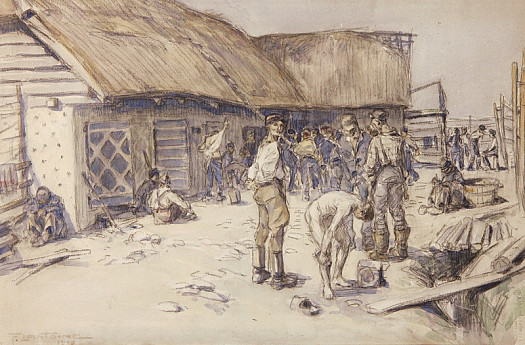Fernand Désiré Louis Lantoine (1876-1955)
Fernand Lantoine’s first experience of the light of the Mediterranean transformed his painting style from austere realist to vibrant colourist. This would provide the foundation of his later career, in which he worked for extended periods in Africa and produced striking Orientalist images. However, this development was interrupted during the First World War, when he became a prisoner of the Germans and forced to work on the Russian front. Even this distressing experience inspired his art, as he recorded camp life in acclaimed drawings and watercolours.
The son of a doctor, Fernand Lantoine was born in Maretz, in northern France, on 13 April 1876. At the age of 15, he moved to Belgium, and settled in Uccle, south of Brussels.
It remained his base for five decades. Between 1894 and 1897, he undertook military service in the 4th Infanterie de Marine at Brest. From about 1897, he studied in Paris at the Ecole des Beaux-Arts, and while in the city befriended the pointillist, Paul Signac. Returning to Brussels, he joined the realist artists’ group, Le Sillon, and exhibited at the Salon de la Libre Esthétique and, in 1903, at the Salon triennal des Beaux-Arts. From 1907, he also exhibited in Paris, at the Salon des Indépendants. Travel to the Côte d’Azur and the Balearic Islands opened his eyes to the light of the Mediterranean, and led him to adopt a pointillist style, which he later modified with an increase of structure.
Soon after the outbreak of the First World War, Lantoine was caught up in the siege of Maubeuge, on the French-Belgian border, and became a prisoner in that town. Subsequently, he was moved to the Rhine, and then to the Neman, which marked the Russian front. There he was made to dig trenches and roads. Nevertheless, he managed to produce drawings and watercolours of his experience, and these became the subject of an important and successful exhibition in 1920. In the following year, he published Histoire complète de la guerre en 25 planches gravées sur bois.
From 1922, Lantoine sailed with the French fleet, as a ‘peintre de la Marine’, during their missions in the Mediterranean and to North Africa. In 1925, he encountered the Belgian Congo, and responded with works that were strikingly simple, in contrast to the mannerism of many contemporary Orientalists. The success of these paintings – exhibited at the Salon des Artistes Français in 1927 – led to his receipt of a commission from the Compagnie Maritime Belge to decorate the ships, Léopoldville and Albertville. He was made a chevalier de la Légion d’Honneur et de l’Ordre belge de la Couronne.
In 1934, Lantoine turned his attention to the north, participating in an exploration of the Arctic and painting the fjords in Norway. The results were exhibited at the Salon in the following year. However, he remained drawn to the south and, in 1936, won the Prix de l’Afrique Occidentale Française. His painting tours were halted during the Second World War, when he lived in Nice, but afterwards resumed, and he explored French West Africa, Somalia, Madagascar and Oceania.
Lantoine died in Maretz, his native village, in 1955.

